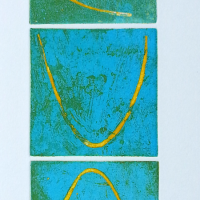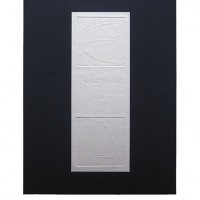Johannistag
Wagners Meistersinger von Nürnberg als Sommernachtstraum…
…Das ist das Thema von Johannistag, das nach fast vier Jahren der Arbeit Ende 2014 mit der letzten Radierung der Auflage endlich fertig geworden ist.
Die vielen Parallelen zwischen den Werken sind mir irgendwann aufgefallen; in beiden verschwimmen die Grenzen zwischen Traum und Wahn und lassen diese zu Kunst verschmelzen. Die Handwerker spielen auf und machen großes Theater. Und die Nacht, in der sie das tun, bringt ein scheinbar heilloses Durcheinander. Aber am Schluß wird der Zauber gelöst, der Traum gedeutet und die Liebenden vereint.
Die Texte sind aus den Meistersingern und aus Shakespeares Sommernachtstraum im Original und in der Übersetzung von A. W. von Schlegel auf halbtransparentem Japanpapier gedruckt, sodaß die verschiedenen Ebenen durchscheinen.
Das Ergebnis ist ein Mappenwerk mit insgesamt 12 Farbradierungen in einer Auflage von 25, in einer nachtblauen Kassette von Anett Arnold in Hamburg. Mehr Details finden Sie unten.
Wagner’s Meistersinger as a Midsummer Night’s Dream…
…that is the theme of this folio work, Johannistag. It is a work that has taken about four years to come to fruition, and the last etching of the edition was printed on the last day of 2014.
Wagner’s opera Die Meistersinger von Nürnberg has fascinated me for a long time. Somewhere along the way I realised there were many parallels to be found between this work and Shakespeare’s Midsummer Night’s Dream. Johannistag is a fusion of dream and midsummer madness, in which the craftsmen – or the rustics – present the theatrical backdrop to a magical transformation from dream to art.
The choice of texts reflects this; extracts from Wagner’s Meistersinger and from Shakespeare’s A Midsummer Night’s Dream (in the original and in Schlegel’s translation) are printed on semi-transparent Japanese paper so that the different layers can be seen simultaneously.
The result is a folio work in an edition of 25 copies, encased in a midnight-blue box by Anett Arnold in Hamburg. More details can be found below.
Technisches
Details zum WerkAuflage von 25 Kassetten mit jeweils drei Innenmappen und insgesamt zwölf Farbradierungen in Simultandruck. Jede Mappe ist eine Art chemise mit einem handgesetzten Text in Buchdruck, der auf Japanpapier gedruckt ist und halbtransparent wie eine geträumte Partitur wirkt.
Das Papier für die Radierungen, die geprägte Intarsie der Kassette und die Innenmappen ist Rives-Bütten »Moulin du Gué« 270 g/qm, das Japanpapier handgeschöpftes Kozo, 34 g/qm.
Satz: Monotype Gill 12 pt, im Museum der Arbeit gegossen, und Unger Fraktur 2 cic und 3 cic, Handsatz. Die Unger-Schrift und die Matritzen der Gill entstammen der berühmten Druckerei J.J. Augustin in Glückstadt.
Einband
Die Kassette wurde von Anett Arnold in nachtblauer Seide und Kalbsleder mit einer blindgeprägten Intarsie aus dem Rives-Bütten gefertigt.
Format: 30,7 x 40,7 cm. Impressum: Hirundo Press, 2014.
Edition of 25 boxed copies, each containing three chemise folders (Acts I, II and III). Altogether there are twelve etchings in simultaneous colour printing. Each chemise opens out to reveal three etchings on the right and text on the left which can be unfolded like a half-dreamt musical score and is letterpress-printed on Japanese paper.
The paper for the etchings, the embossed panel for the box and the three folders is 270 gsm Rives Moulin du Gué, the Japanese paper is 34 gsm handmade Kozo.
Type: Monotype Gill 12 pt, cast in the Museum of Work in Hamburg, and 2 cic / 3 cic Unger. The Unger type and the matrices for the Gill Monotype were loaned from the famous printers J.J. Augustin in Glückstadt.
Binding
The box by Anett Arnold is bound in midnight blue silk and calf, with front embossed inlay on Moulin du Gué paper.
Format: 30.7 x 40.7 cm. Colophon: Hirundo Press, 2014.
Kassette / Box: Preis auf Anfrage / please ask
















